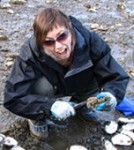 Program: Interdisciplinary PhD in Urban Design and Planning
Program: Interdisciplinary PhD in Urban Design and Planning
Thesis Title: Urban patterns in near-shore ecosystems: examining the role of alternative wastewater Infrastructures in mediating the impacts of urbanization in the Puget Sound
danieles@hawaii.edu
Coastal areas are unique places in their productivity, value, and fragility. They are also unique places for people to live, play, work, navigate and experience. These “living edges” have provided countless benefits to humans for millions of years, none as essential as providing an ecological niche where there are no major competing mammals and where local livelihood is intimately connected with the ecosystem (Walker, 1990). Coastal areas are also attractive to tourists and outside fishing markets. While coastal areas are valuable places for residents, recreationists, and individuals whose livelihoods depend upon shellfish and local resources, these same people are faced with increasing risks to a host of pathogens, viruses, and toxins. Water pollution is a significant threat to human health through the consumption of contaminated food or drinking water, the ingestion of recreational water and skin exposure to contaminants present in the coastal waters (Lipp et al. 2001).
Landscape change associated with urbanization in nearshore environments puts the health of humans and ecosystems at risk. Urbanization has increased significantly in coastal and nearshore areas, accommodating larger proportions of people. In U.S. coastal communities alone, population growth has increased by 33 million people between 1980 and 2003, nearly a 28 percent jump.
My research interests involve three broad questions:
- What is known about the relationships between patterns of urban development, ecological integrity and human well-being in nearshore environments?
- What is the relative importance of land use, land cover, and wastewater infrastructure for nearshore conditions and shellfish habitat in an urbanizing region?
- When examining health risks that are elusive and mostly hidden from management efforts, such as non-point source pollution, are principles of complexity theory transformative to the contemporary risk assessment framework?
Lipp, EK, SA Farrah, and JB Rose. 2001. “Assessment and Impact of Microbial Fecal Pollution and Human Enteric Pathogens in a Coastal Community.” Marine Pollution Bulletin 42.4: 286-293.
Funding: NOAA Northwest Fisheries Science Center
Alberti M., Booth D., Hill K., Coburn B., Avolio C., Coe S., Spirandelli D. 2007. The impact of urban patterns on aquatic ecosystems: An empirical analysis in Puget Sound lowland sub-basins. Landscape and Urban Planning 80: 345-361
Spirandelli, D. and M. Alberti. Land cover change in the Puget Sound: A key link between urbanization, ecosystem function, and human health. South Sound Symposium, March 2008. Tacoma, WA.
Spirandelli, D and M. Alberti. Landscape Metrics for Monitoring Landscape Change in Western Washington. Georgia Basin Conference 2007, Vancouver B.C.
Posters:
Spirandelli D., Emmanuelson D., Spahn E. Quantifying Nitrogen Sources in the Hood Canal. Hood Canal Dissolved Oxygen Program Annual Meeting. Bremerton, WA. June 30, 2008.
Spirandelli, D., Younglove, L., Demmy-Bidwell M., Alberti, M., Faustman, E., Fay, K., Drew, C., Judd, N., Newton, J. Integrated Framework of Urbanization, Nearshore Ecosystem and Human Health Interactions. Georgia Basin Conference 2007. Vancouver, B.C.
[project_list page=”1139″]